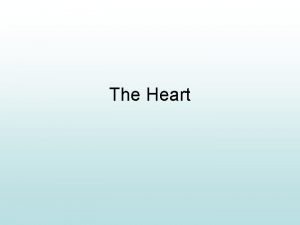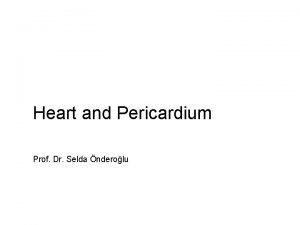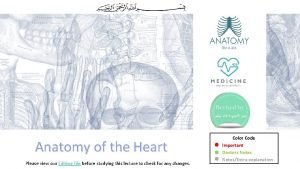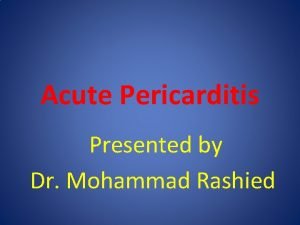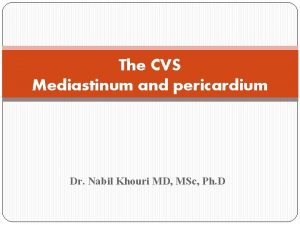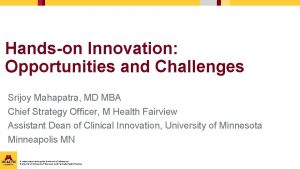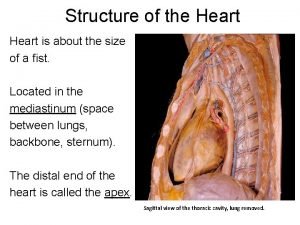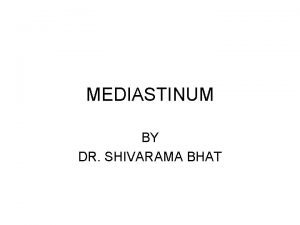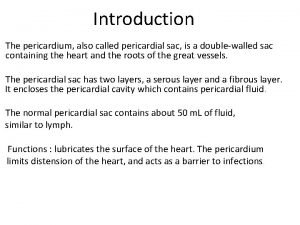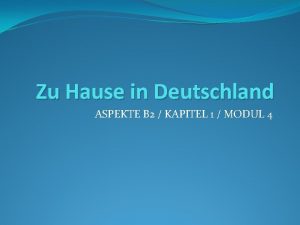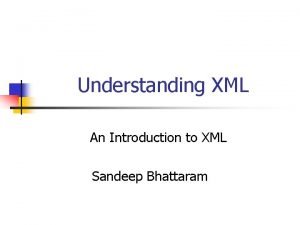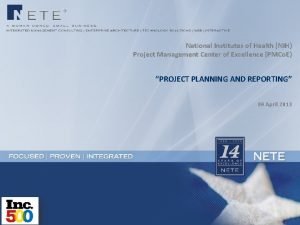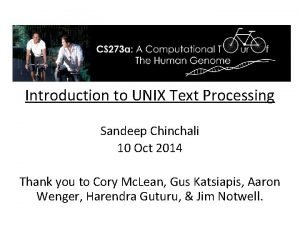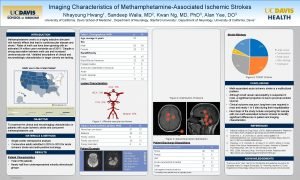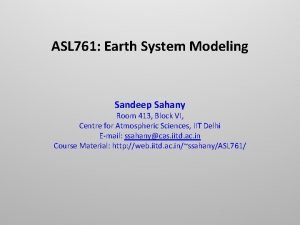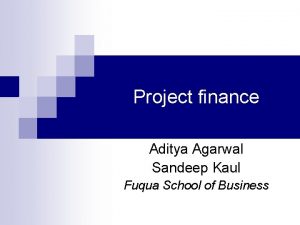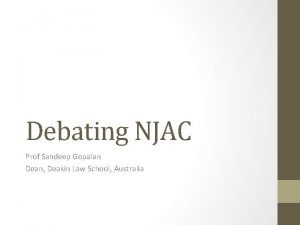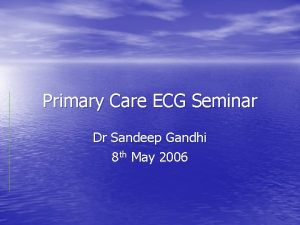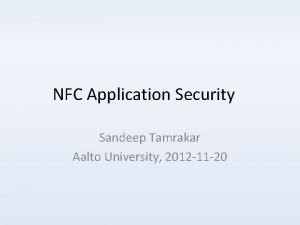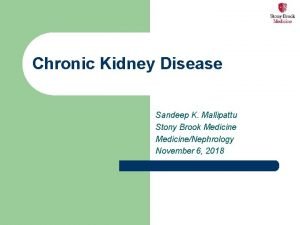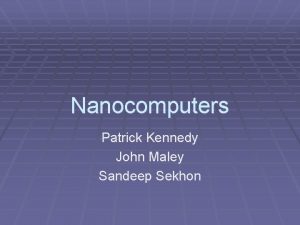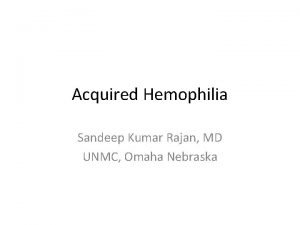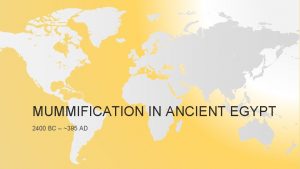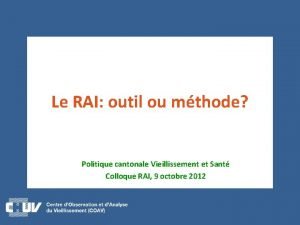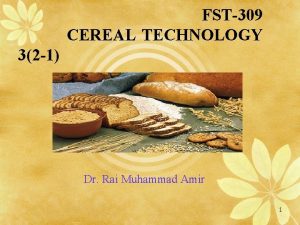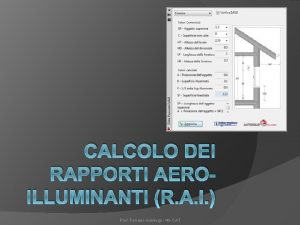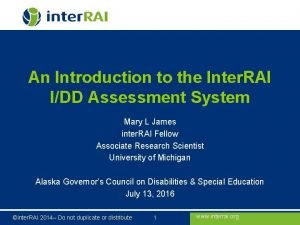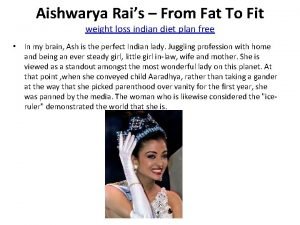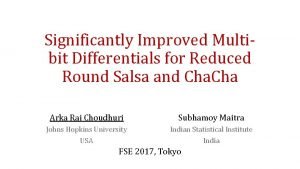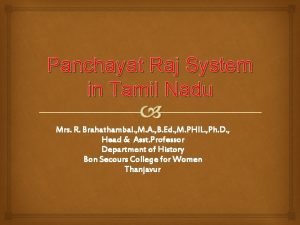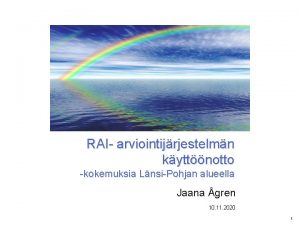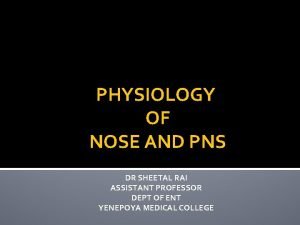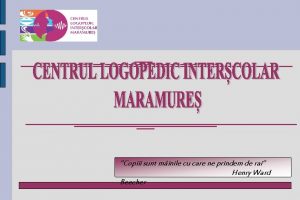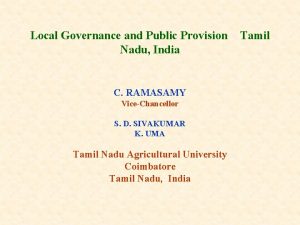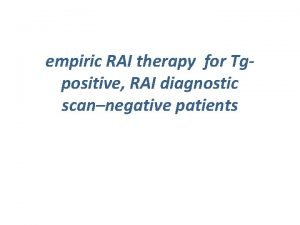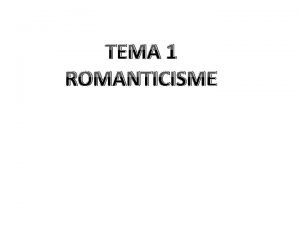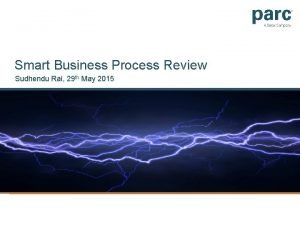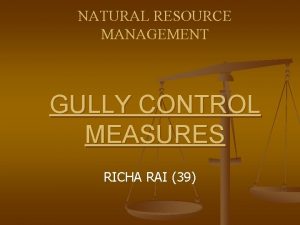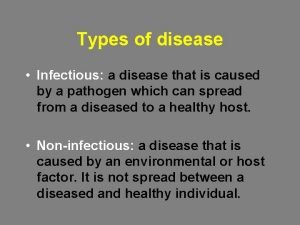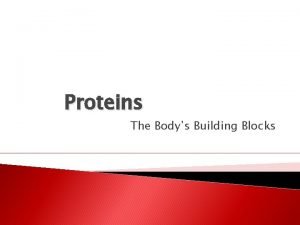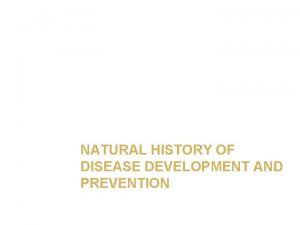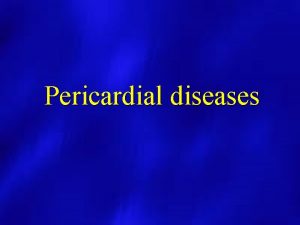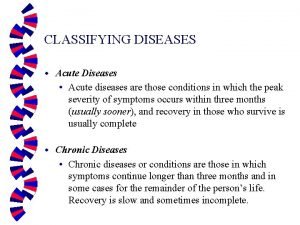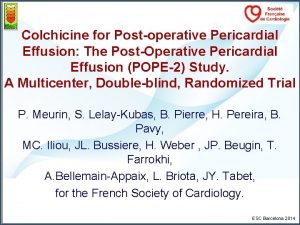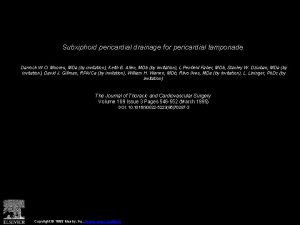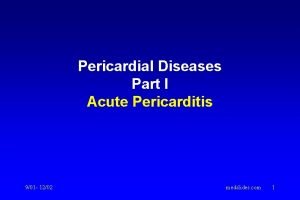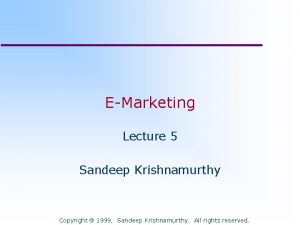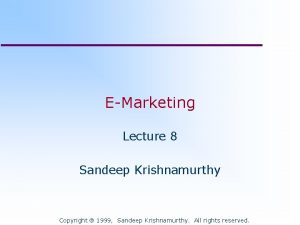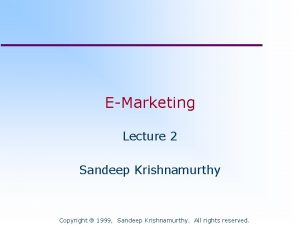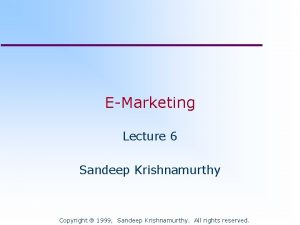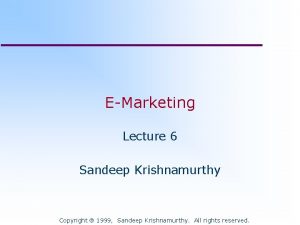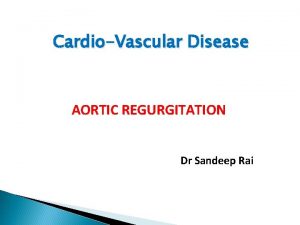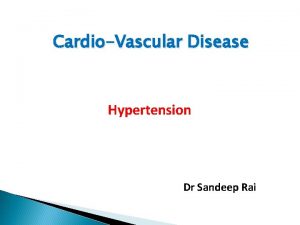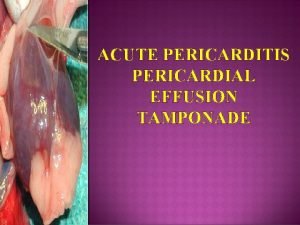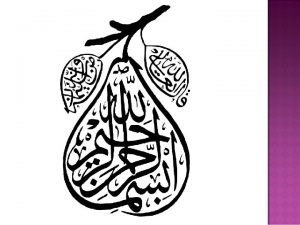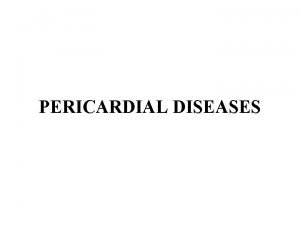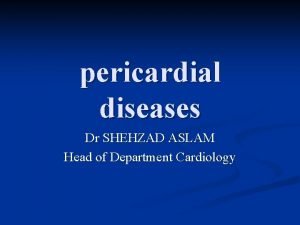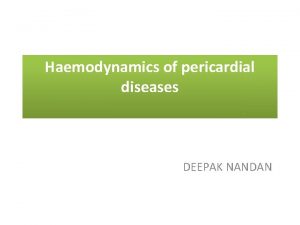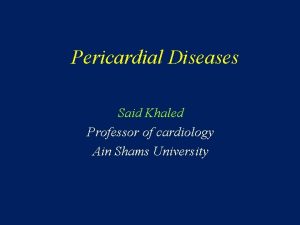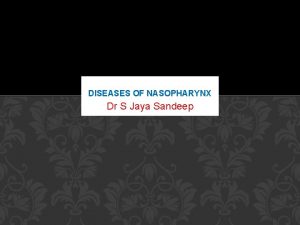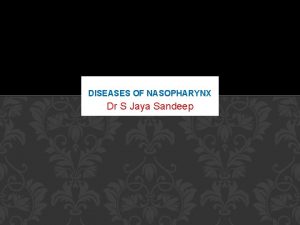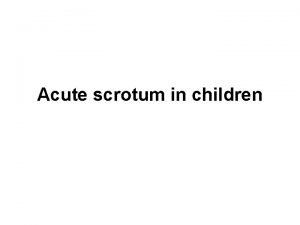Pericardial diseases Dr Sandeep Rai Overview Introduction Acute

































































- Slides: 65

Pericardial diseases Dr Sandeep Rai

Overview • • • Introduction Acute pericarditis Constrictive pericarditis Pericardial effusion Cardiac tamponade





Functions 1. Stabilization of the heart within the thoracic cavity by virtue of its ligamentous attachments -- limiting the heart’s motion. 2. Protection of the heart from mechanical trauma and infection from adjoining structures. 3. The pericardial fluid functions as a lubricant and decreases friction of cardiac surface during systole and diastole. 4. Prevention of excessive dilation of heart especially during sudden rise in intra-cardiac volume (e. g. acute aortic or mitral regurgitation).

Acute pericarditis

Acute pericarditis • Most common pathologic process involving the pericardium. • Classification Of Pericarditis : Clinical Etiological

Clinical classification

Etiological classification T = Trauma, Tumour U = Uremia M = Myocardial infarction (acute, post) Medications (hydralazine) O = Other infections (viral, bacterial, fungal, TB) R = Rheumatoid, autoimmune disorder Radiation

Clinical features Preceded by fever, malaise and myalgia Common characteristics of pain retrosternal or precordial with radiation to the trapezius ridge, neck, back, left shoulder or arm Special characteristics of pericardial pain more likely to be sharp with coughing, inspiration, swallowing worse by lying supine, relieved by sitting and leaning forward

Pericarditis vs MI

Clinical features • Triphasic friction rub is pathognomonic; scratching or grating sound; evanescent • Best heard in the lower LSB with the patient sitting and leaning forward Pericardial rub Pleural rub Can be heard even after cessation of breathing Can be heard only during inspiration and expiration Heard mostly over the sternum or sternal borders Heard mostly over the lateral parts of the chest Intensity doesn’t increase with increased pressure of the steth Intensity of rub increases with increased pressure of the steth over the chest wall




Acute Pericarditis Management • Treat underlying cause • Analgesic agents – codeine 15 -30 mg q 4 -6 hrs • Anti-inflammatory agents – Aspirin – NSAID (indomethacin 25 -50 mg qid) – Corticosteroids are symptomatically effective , but preferably avoided 16

Pericarditis after AMI Early Occurs - 1 to 3 days (no more than a week due to transmural necrosis with pericardial inflammation 40% of patients with large, Qwave MIs have pericarditis Benign aspirin doses (650 mg orally three or four times per day for 2 to 5 days) or acetaminophen is usually effective Late (Dresslers Syndrome) Occurs - 1 week to a few months after AMI. autoimmune etiology 3% to 4%. Polyserositis with pericardial or pleural effusions Aspirin , Colchicine. Prednisone, 40 to 60 mg /d with a 7 - to 10 -day taper(If not responding to treatment or for recurrent symptoms)

Constrictive pericarditis

Etiology Idiopathic or viral — 42 to 49 % Post cardiac surgery — 11 to 37 % Post radiation therapy — 9 to 31 % Connective tissue disorder — 3 to 7 % Postinfectious (tuberculous or purulent pericarditis) — 3 to 6 % • Miscellaneous causes (malignancy, trauma, drug-induced, asbestosis, sarcoidosis, uremic pericarditis) — 1 to 10 % • • •

Pathophysiology • A thickened, fibrotic pericardium forms a noncompliant shell around the heart (“constricts it”). • Ventricles are like a fixed cavity; encased by the thick pericardium • This shell prevents the heart from expanding when blood enters it. • So it interferes with ventricular filling

Pathophysiology • In early diastole the ventricle relaxes (expands) to a certain extent and stops abruptly because it cannot expand any more • Almost all of the ventricular filling occurs in early diastole; very little filling in late diastole because the ventricle cannot expand any more • CP restriction of filling in late diastole • Filling of one ventricle occurs at the expense of the other ventricle



Pericardium – Rigid and Scarred Systemic > pulmonary venous congestion Hepatic congestion, peripheral edema, ascites , anasarca, and cardiac cirrhosis. Reduced cardiac output : Consequence of impaired ventricular filling causes fatigue, muscle wasting, and weight loss

Clinical findings Rigid, scarred pericardium encircles heart: Systolic contraction normal Inhibits diastolic filling of both ventricles SV venous pressures CO Hypotension/shock Reflex tachycardia systemic JVP hepatomegaly ascites peripheral edema pulmonary ↓ lung signs

Physical examination BP, HR JVP ascites, edema, hepatomegaly early diastolic “knock” after S 2 sudden cessation of ventricular diastolic filling imposed by rigid pericardial sac Kussmaul’s sign inspiratory increase in JVP

Kussmaul’s sign • In Inspiration : – Normal : • RV Volume increases without increase in RA pressure. – In Constrictive pericarditis : • RV volume increases , as the RV cannot expand due to thickened pericardium , this results in increase in RA pressure which causes Elevated JVP in inspiration.

Diagnosis • Clinical suspicion followed by confirmation with certain diagnostic tests ( many patients are initially seen for abdominal symptoms) • ECG : AF in 1/3 rd of patients flattened or inverted T waves

Chest X ray Pericardial calcification

• Echocardiogram - pericardial thickening - septal bounce : abrupt displacement of IVS during early diastole - restrictive filling pattern - >25% increase in mitral E velocity during expiration compared with inspiration



CP vs RCM (echo) Constriction Restriction 2 D 2 D • Pericardial thickening • Normal chamber wall thickness • Septal bounce • • Doppler • > 25% ↓ in mitral E velocity with inspiration • ↑ tricuspid flow with insp • ↑HV diastolic flow reversal with inspiration • Tissue doppler E’ : > 8 cm /sec Increased wall thickness Thickened valves Atrial enlargement Speckling Doppler • MR, TR • ↑ HV diastolic flow reversal with expiration • Tissue doppler E’ : < 8 cm/sec

Confirmation is usually through CT / MRI

Management Cautious diuretics and salt restriction Sinus tachycardia is a compensatory mechanism, BB and CCB that slow the HR should be avoided. In patients with AF with FVR , digoxin is recommended as initial treatment to slow the ventricular rate before resorting to beta blockers or calcium antagonists. In general, the rate should not be allowed to drop 80 -90 / min • Definitive treatment : surgical pericardiectomy

Pericardial effusion

• Accumulation of fluid between the visceral and parietal layers of serous pericardium • Serous – Transudative – CHF , Renal failure • Suppurative – Pyogenic infection • Hemorrhagic – occurs with any type of pericarditis – especially with infections and malignancies

Etiology 1. Inflammation from infection, immunologic process. 2. Trauma causing bleeding in pericardial space. 3. Noninfectious conditions such as: a. increase in hydrostatic pressure e. g. congestive heart failure. b. increase in capillary permeability e. g. hypothyroidism c. decrease in plasma oncotic pressure e. g. cirrhosis. 4. Decreased drainage of pericardial fluid due to obstruction of thoracic duct as a result of malignancy or damage during surgery.

Quantification • Trivial : 50 – 100 cc • Small : 100 cc • Moderate : 500 cc • Large : 1000 cc

Clinical features • Usually asymptomatic • Can have signs of compression - dyspnoea, dysphagia, hoarseness of voice, hiccoughs, nausea • Signs : muffled heart sounds paradoxically reduced intensity of rub

Chest x ray – usually requires > 200 ml of fluid – cannot distinguish between pericardial effusion and cardiomegaly

Electrocardiogram Low voltage complexes

Echocardiogram

Management • Depends on the etiology , presence of hemodynamic compromise and the volume of fluid. • No role for diuretics • Pericardiocentesis is not always necessary. • Pericardiocentesis if Malignancy or Purulent pericarditis is suspected Hemodynamic compromise present

Cardiac tamponade

What is Tamponade ? • Accumulation of fluid in the pericardial space causing increase in pressure with subsequent cardiac compression. • Pericardial pressures > intracardiac pressures • Most common causes : – Malignancy – Idiopathic pericarditis – Renal failure. – Bleeding following cardiac Sx and trauma , TB & Hemopericardium




Pathophysiology – Most critical point occurs when an effusion reduces the volume of the cardiac chambers such that cardiac output begins to decline – Mainly by impeding right-sided heart filling, with much of the effect on the left side of the heart due to secondary under filling.

Pathophysiology • A ) Modest amounts of rapidly accumulating fluid can have major effects on cardiac function. • B) Large, slowly accumulating effusions are often well tolerated, presumably because of chronic changes in the pericardial pressurevolume relation described earlier.

Cardiac Tamponade -- Pathophysiology Accumulation of fluid under high pressure: compresses cardiac chambers & impairs diastolic filling of both ventricles SV venous pressures CO systemic Hypotension/shock Reflex tachycardia JVP hepatomegaly ascites peripheral edema

Clinical features • Symptoms acute : confusion / agitation • Signs ( Becks triad) - hypotension - elevated JVP - muffled heart sounds Pulsus paradoxus : insp drop in SBP > 10 mmhg Pulsus paradoxus also seen in CP, COPD, asthma

Pulsus Paradoxus • When severe, it may be detected by palpating weakness or disappearance of the arterial pulse during inspiration. • Measured by noting the difference between the systolic pressure at which the Korotkoff sounds are first heard (during expiration) and the systolic pressure at which the Korotkoff sounds are heard with each beat, independent of respiratory phase • Between these two pressures, the sounds are heard only intermittently (during expiration).

• Since both ventricles share a tight incompressible covering, the inspiratory enlargement of the RV compresses and reduces LV volume; leftward bulging of the IVS further reduces the LV cavity as the RV enlarges during inspiration • The normal inspiratory augmentation of RV volume causes an exaggerated reciprocal reduction in LV volume.

JVP • Elevated JVP with prominent positive ways : heart failure • Elevated JVP with prominent negative ways : pericardial disease • Elevated JVP with absent pulsations : SVC obstruction

ECG

Chest x ray • Cardiac shadow rounded ; Flask like appearance • Lungs appear oligemic

Echocardiogram RA collapse RV collapse

Echocardiogram • Dilated IVC with minimal or no collapse • Restrictive filling pattern • Significant respiratory variation in filling pattern • Tamponade : equal and continuous restriction throughout diastole • CP : Restriction to filling in late diastole

Management • Avoid diuretics • Adequate preload • Pericardiocentesis • Pericardial window • Pericardiectomy in select cases

Take aways…

Take aways… • • Symptoms may be non cardiac CP and PE will mimic right heart failure In any RHF symptoms rule out pericardial disease Because treatment is completely different (diuretics, digoxin) • Clinical suspicion is essential for diagnosis • Correct diagnosis is imperative • Potential for permanent cure
 Visceral pericardium covers the
Visceral pericardium covers the Blood supply of mediastinum
Blood supply of mediastinum Oblique pericardial sinus
Oblique pericardial sinus L
L Pericardial sinuses
Pericardial sinuses Kussmal sign
Kussmal sign Mediastinum contents
Mediastinum contents Pericardial membrane
Pericardial membrane Pericardial cavity
Pericardial cavity Pericardial sinuses
Pericardial sinuses Epicardium
Epicardium Parietal layer of serous pericardium
Parietal layer of serous pericardium Sandeep singh jolly berlin
Sandeep singh jolly berlin Sandeep bhattaram
Sandeep bhattaram Sandeep somaiya
Sandeep somaiya Sandeep chinchali
Sandeep chinchali Dr sandeep walia
Dr sandeep walia Sandeep sahany
Sandeep sahany Sandeep agarwal aditya birla
Sandeep agarwal aditya birla Dean deakin
Dean deakin Dr sandeep gandhi
Dr sandeep gandhi Sandeep tamrakar
Sandeep tamrakar Sandeep mallipattu
Sandeep mallipattu Gampa sandeep
Gampa sandeep Dr sandeep sekhon
Dr sandeep sekhon Sandeep modhvadia
Sandeep modhvadia Sandeep modhvadia
Sandeep modhvadia Sandeep baruah
Sandeep baruah Sandeep rajan md
Sandeep rajan md What is bioinformatics an introduction and overview
What is bioinformatics an introduction and overview Papercut job ticketing
Papercut job ticketing Introduction product overview
Introduction product overview Introduction product overview
Introduction product overview Introduction product overview
Introduction product overview Lady rai mummy
Lady rai mummy Rai oyau
Rai oyau Naomi rai
Naomi rai Rai cereal
Rai cereal Arushi rai
Arushi rai Rai rapporto aeroilluminante
Rai rapporto aeroilluminante Rai cmh
Rai cmh Aishwarya rai dhoom 2 weight loss
Aishwarya rai dhoom 2 weight loss Arka rai choudhuri
Arka rai choudhuri Piattaforma acquisti rai
Piattaforma acquisti rai G.v.k. rao committee in tamil
G.v.k. rao committee in tamil Swot haagen dazs
Swot haagen dazs Rai kamaluddin
Rai kamaluddin Rai koulutus
Rai koulutus Rai
Rai Rai narita
Rai narita Sheetal rai
Sheetal rai Trombocitop
Trombocitop Copiii sunt mainile cu care ne prindem de rai
Copiii sunt mainile cu care ne prindem de rai Kamalzar
Kamalzar Balwant rai mehta committee
Balwant rai mehta committee Naomi rai
Naomi rai Rai diagnostic
Rai diagnostic El rai de la medusa comentario
El rai de la medusa comentario Smart business process
Smart business process Richa rai
Richa rai Peran letnan kolonel i gusti ngurah rai
Peran letnan kolonel i gusti ngurah rai Binita rai
Binita rai Types of diseases
Types of diseases Quality gurus meaning
Quality gurus meaning Protein deficiency diseases
Protein deficiency diseases What is natural history of disease
What is natural history of disease
